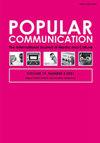Makeover media as fashion journalism: What Not To Wear, fashion, authority, and Gonzo subjectivity
IF 1.8
Q2 COMMUNICATION
引用次数: 1
Abstract
ABSTRACT The USA-based television program What Not To Wear (WNTW) was a staple of popular fashion media, informing audiences about acceptable modes of dress and appearance. We consider how aspects of this show and its accompanying book encompass features of traditional fashion reportage – particularly advice literature – and also approaches to fashion communication that overlap with the style and concerns of “New Journalism” (those modes of reporting – sometimes called “Gonzo” – that emphasize informality, emotional engagement, and an interest in “real” people and “real” lives). By examining the text, images, and talk deployed by the book and the TV show, we indicate how WNTW perceives, constructs, and conveys the fashioned subject in ways that link makeover media to broader contexts of cultural commentary.作为时尚新闻的改头换面媒体:不该穿什么、时尚、权威和Gonzo的主观性
摘要美国电视节目《不穿什么》(What Not To Wear,WNTW)是流行时尚媒体的主要节目,向观众介绍可接受的着装和外表模式。我们考虑了这场展览及其配套书籍的各个方面如何涵盖传统时尚报告文学的特征,特别是建议文学,以及与“新新闻”的风格和关注点重叠的时尚传播方法(这些报道模式——有时被称为“Gonzo”——强调非正式、情感参与和对“真实”的人和“真实”生活)。通过研究这本书和电视节目所使用的文本、图像和谈话,我们指出了WNTW是如何感知、构建和传达传统主题的,将改造媒体与更广泛的文化评论背景联系起来。
本文章由计算机程序翻译,如有差异,请以英文原文为准。
求助全文
约1分钟内获得全文
求助全文

 求助内容:
求助内容: 应助结果提醒方式:
应助结果提醒方式:


